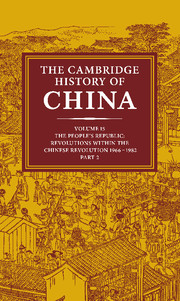Book contents
- Frontmatter
- 1 Mao Tse-tung's thought from 1949 to 1976
- PART I THE CULTURAL REVOLUTION: CHINA IN TURMOIL, 1966–1969
- PART II THE CULTURAL REVOLUTION: THE STRUGGLE FOR THE SUCCESSION, 1969–1982
- PART III THE CULTURAL REVOLUTION AND ITS AFTERMATH
- PART IV LIFE AND LETTERS UNDER COMMUNISM
- 9 The countryside under communism
- 10 Urban life in the People's Republic
- 11 Literature under communism
- PART V THE SEPARATED PROVINCE
- Epilogue: the onus of unity
- Appendixes: meetings and leaders
- Bibliographical essays
- Bibliography
- Index
- Map 1: China’s physical features
- Map 2. PRC: political (Wade–Giles romanization)
- Map 3. PRC: political (pinyin romanization)
- Map 7: Population
- References
9 - The countryside under communism
from PART IV - LIFE AND LETTERS UNDER COMMUNISM
Published online by Cambridge University Press: 28 March 2008
- Frontmatter
- 1 Mao Tse-tung's thought from 1949 to 1976
- PART I THE CULTURAL REVOLUTION: CHINA IN TURMOIL, 1966–1969
- PART II THE CULTURAL REVOLUTION: THE STRUGGLE FOR THE SUCCESSION, 1969–1982
- PART III THE CULTURAL REVOLUTION AND ITS AFTERMATH
- PART IV LIFE AND LETTERS UNDER COMMUNISM
- 9 The countryside under communism
- 10 Urban life in the People's Republic
- 11 Literature under communism
- PART V THE SEPARATED PROVINCE
- Epilogue: the onus of unity
- Appendixes: meetings and leaders
- Bibliographical essays
- Bibliography
- Index
- Map 1: China’s physical features
- Map 2. PRC: political (Wade–Giles romanization)
- Map 3. PRC: political (pinyin romanization)
- Map 7: Population
- References
Summary
In his famous “Investigation of the peasant movement in Hunan,” Mao Tse-tung described “four thick ropes binding the Chinese people, particularly the peasants.” These ropes represented the bonds of four kinds of authority:
(1) the state system (political authority) …; (2) the clan system (clan authority), ranging from the central ancestral temple and its branch temples down to the head of the household; and (3) the supernatural system (religious authority), ranging from the King of Hell down to the town and village gods belonging to the nether world, and from the Emperor of Heaven down to all the various gods and spirits belonging to the celestial world. As for women, in addition to being dominated by these three systems of authority, they are also dominated by the men (the authority of the husband). These four authorities - political, clan, religious, and masculine - are the embodiment of the whole feudal-patriarchal system and ideology.
In their drive for power, the Chinese Communists attempted to build a base of peasant support by severing and reweaving these bonds of authority; and they continued this process after they took control of the country in 1949. Although their efforts did indeed lead to important alterations in the fabric of Chinese rural life, the traditional patterns of peasant life seem to have had more resilience than the Communists had counted on, and the changes that actually occurred in those patterns were often different from what they had intended.
Keywords
- Type
- Chapter
- Information
- The Cambridge History of China , pp. 617 - 681Publisher: Cambridge University PressPrint publication year: 1991
References
- 1
- Cited by

